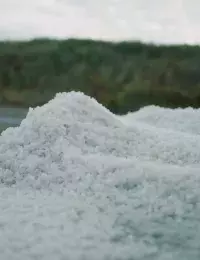
Where does salt come from: what does history tell us?
From the earliest human civilizations to the present day, salt has always occupied a central place in societies. At once a natural resource, an economic engine and a cultural symbol, it tells a fascinating story that spans the ages. Le Guérandais takes you on a journey to discover the origins of salt, its impact on humanity and how it is still harvested in the traditional way in iconic places like the Guérande salt marshes.
Summary
A geological origin dating back thousands of years
The story begins millions of years ago when shallow seas and underground rivers evaporate, leaving behind layers of crystallized sodium chloride buried beneath the earth: salt. These deposits, known as evaporites, are mined today in the form of rock salt, or "halite".
Rock salt is generally extracted directly from underground mines, where it comes in the form of solid crystals that can be very large. It is used in cooking, for clearing snow from roads, for making chemicals, for generating electricity...
But the history of salt doesn't end there. From time immemorial, populations have learned how to bring salt into existence and exploit it with their own means. Salt marshes, for example, reveal another facet of salt production. In salt marshes, ocean water is directly transformed into salt thanks to an ancestral know-how based on the forces of nature: water, sun, wind.
.Did you know?
If you put together the amount of salt present in our oceans, it would form a thickness of over 166 meters!
Numerous production methods through the ages
The birth of salt from prehistory to the present
Over the centuries, salt production methods have evolved. While early civilizations used rudimentary evaporation ponds, modern techniques, such as mining or the use of salt marshes, now enable more sustainable salt production. Each method reflects an ingenious adaptation to the resources and climate of the regions concerned. Le Guérandais takes you on a tour of salt production methods through the ages.
In prehistoric times, the sand salt technique involved recovering salt crystals formed naturally on beach sand after the salt water had receded. At this time, the ash salt technique was also used, which involved burning wood or vegetation in salt-rich areas, in order to extract a raw salt contained in the ashes.
During the Iron Age, Gallic salt furnaces were terracotta installations used to cook large quantities of brine. The furnaces were built near salt springs and show the advanced organization of production at that time.
Igneous, briquetting, salt cooking techniques came into being during antiquity:
- Briquetting:this technique, used as early as prehistoric times and perfected in Gallic times, involved heating brine in clay pots to crystallize the salt. Brickwork residues and ceramic fragments testify to the scale of this production. This process was particularly widespread in areas without salt marshes.
- Firing salt: this method involved heating the brine directly to accelerate crystallization. It was used in cold or poorly sunlit regions, where natural evaporation was not effective.
- Igneous techniques:these methods relied on the use of fire to concentrate brine or cook salt-rich materials. They were widespread in areas where natural evaporation was insufficient.
From prehistoric times to the Middle Ages, the ancient method of vegetable salt-making involved harvesting halophilic plants, burning them, then washing the ashes to extract the salt. Used in regions without direct access to salt water, it provided an impure but valuable salt.
In the Middle Ages, the medieval sand washing technique was used on coasts where the sand was rich in salt. The sand was rinsed with fresh water to form a brine, then heated to extract the crystals. It met the needs of populations living far from rock salt sources or marshes.
The extraction of rock salt in underground mines began in antiquity, notably in Central Europe and Asia. Today, this method remains an important source of industrial production.
Salt marshes came into being in antiquity. Originating in Neolithic times and perfected by the Romans, they use the natural evaporation of seawater thanks to the sun and wind, and today remain an emblematic method for producing high-quality salt, as in Guérande.
In salt marshes, salt is produced according to a know-how that has remained virtually unchanged for centuries. This delicate, meticulous process relies on the natural evaporation of saltwater from the Ocean in successive basins. The ocean water is conveyed to the vasières, large basins where it is clarified. This salt water is then directed into several smaller settling basins, where it concentrates its salt content under the effect of the sun and wind. Finally, the water ends its journey in the œillets, where the high salt concentration allows crystallization and the birth of salt.
An ancestral method: crystallization in the Guérande salt marshes
In the Guérande salt marshes, water from the Atlantic Ocean is conveyed to the œillets via the Traict du Croisic. It is then in the midst of the enchanting world of the Guérande salt marshes that its treasures are born: the gros sel and the Fleur de sel.
The coarse salt is born at the bottom of the œillets in contact with the clay that gives it its natural gray color. It is then carefully hand-picked by the Cooperative's salt workers using a traditional tool, the las. The ground salt, or fine salt, is a coarse salt that is dried and ground.
The Fleur de sel, or white gold of the marshes, forms on the surface of the water thanks to the perfect combination of sun and wind on hot summer afternoons. It is then delicately harvested by hand by paludiers using another traditional tool, the lousse.
Authentic creations of nature that Man has learned to tame in order to perpetuate an ancestral know-how.
Le Guérandais Guérande Salt is a natural salt, unrefined, unwashed and unbleached that has preserved all its natural benefits. Each year, it is harvested by hand in the Guérande salt marshes by salt workers who are members of the Coopérative.
Salt in human history: a priceless treasure
An essential resource for survival
In ancient times, salt played a vital role. As well as seasoning dishes, it was used to preserve food, enabling populations to store meat and fish over long periods. A property that made it indispensable in societies where refrigeration did not exist.
The Egyptians, for example, used salt to preserve food but also in the mummification process, to preserve bodies for eternity.
The Romans, for their part, employed salt in their diet and religious rituals. In fact, the word "salary" has its origins in salt: Roman soldiers received part of their pay in salt, called salarium.
An economic and strategic engine
In the Middle Ages, the salt trade became a major activity. Salt routes crisscrossed Europe and Asia, transporting this "white gold" from production areas to distant markets. In France, the gabelle, a tax on salt introduced in the XIVᵉ century, underlines the extent to which this resource was considered strategic by the authorities.
En Entire cities, such as Salzburg in Austria or Venice in Italy, built their wealth on the exploitation and trade of salt. In some regions, it even became a currency of exchange, demonstrating its immense social and economic value.
A universal symbol
Salt is not just a food product, it also embodies spiritual and symbolic values.
In Africa, it was considered a symbol of friendship and alliance.
In Asia, salt played a purifying role in religious rituals. It was scattered to ward off evil spirits.
In Europe, offering bread and salt to guests was a gesture of hospitality and respect, often linked to superstitions of protection and prosperity.

A timeless culinary tradition
Beyond its practical utility, salt has shaped gastronomic traditions. It enhances flavors, sublimates dishes and plays a key role in countless recipes. In France, Guérande salt, harvested by hand, enhances the reputation of French gastronomy thanks to its qualities recognized the world over.
Guérande salt stands out for its natural salt quality, subtle aromas and many preserved benefits. In the salt marshes of Guérande, the Cooperative's salt workers are committed to perpetuating an age-old tradition, meticulously tending their salt pans throughout the year to produce and harvest high quality coarse salt and Fleur de sel once summer arrives. Each of these salts has many distinctive taste characteristics and is used differently in cooking.
The Fleur de sel is ideal for sprinkling delicately at the end of cooking to sublimate the dish with its subtle taste and light crunch. Coarse salt, on the other hand, is particularly suitable for use in cooking water, to which it lends great flavor, but also as a seasoning on meats or for cooking in a salt crust. Ground salt, or fine salt, is suitable for all uses.
sources:
https://www.inrap.fr/dossiers/Archeologie-du-Sel/Qu-est-ce-que-le-sel-/Les-usages-sociaux-du-sel
https://www.selsdefrance.org/tout-sur-le-sel/histoires-de-sel/
https://www.futura-sciences.com/planete/dossiers/geologie-route-sel-historique-geologie-alimentation-645/page/5/




